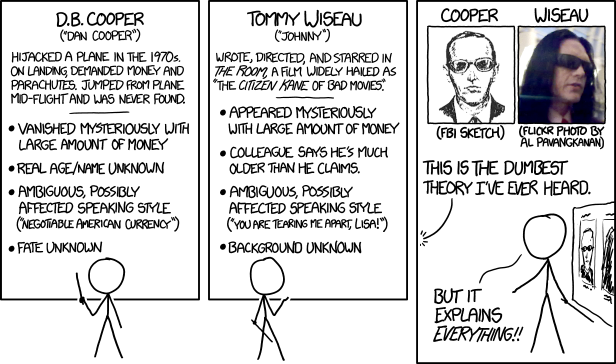Tags
Coming off of Netflix is the 2017 film The Disaster Artist. This is actor James Franco’s tribute to the film The Room, itself a 2003 film by Tommy Wiseau. The latter piece has been called “the Citizen Kane of bad movies;” a work so bad that it has become a cult classic. Franco, himself, in describing why he was driven to make this movie explained that he realized, one day, that he had watch The Room over 50 times – more than he had watched any other movie.
It was a few years back when I first started seeing quotes from The Room which then led me to watch some of the “best of The Room” compilations on YouTube. At first I didn’t get it. Then I became more and more curious as to what this was all about. It helped me along, quite a bit actually, that someone in my neighborhood has an “Oh Hi Mark” vanity license plate – a joke to which I remained oblivious until it hit me like poorly-thrown football to the head. At that moment, I appreciated the demented brilliance of The Room. Somewhere during my journey (and I don’t recall the details) I was able to watch the whole movie. Once.
The Room is something of a phenomenon, I will admit. So, when I read what Franco had done and why, I figured I’d probably appreciate his take. Of course, I didn’t appreciate it enough to actually watch The Disaster Artist. Not until Netflix decided to take it away from me.
The Disaster Artist is, by any measure*, a better film than The Room. Once it hits its stride, it is very funny; both in the generic James Franco/Seth Rogan sense but also due to its stranger-than-fiction subject matter. Franco’s take on Wiseau is very well done. If you stick it out past the end of the film you get to see, first, a side-by-side comparison of the original film and Franco’s reproduction – they are almost dead-on. Next, there is a filmed scene in a bar where Franco’s Tommy meets the real Tommy and they have the kind of conversation that this guy could only have with himself. Part of the charm of The Disaster Artist is that you can experience The Room without, you know, actually having to watch The Room.
One thing I did learn by watching The Disaster Artist is just how strange this all remains to this day.
Even in 2022, much of the truth about Tommy Wiseau (this certainly not his real name) remains a mystery. He claims to be all-American (from New Orleans), despite all evidence to the contrary. The internet crowd has managed to narrow his accent** to a particular city in Poland. Other bits of biography, whether real or contrived, must be sifted out of Wiseau’s version of his life story. One imagines there must be some bits of truth in all the ramblings.
When Wiseau set himself to the making of The Room, he was an aspiring actor living near Hollywood but by no measure a successful one. Some part of this does make sense. How many failed actors would love to just say “**** it! I’m just going to write, direct, and produce my own movie, my own way, and show everyone how it is done?” Yet, how many have actually done it? If it is more than a handful, I’d be surprised. The reason is money.
Somehow this unemployed actor was able to fund a film production to the tune of (by some estimates) north of $6 million. The largess allowed him to make obvious and costly mistakes and yet still see his project through to the end. This bottomless well of money was able to not only push out a project that probably never should have seen the light of day but, by paying theaters to run it and by paying for a Hollywood billboard for 5 years (probably $300,000 right there), kept in in the periphery of the public eye just long enough to garner a cult following.
The movie earned $1,800 in ticket sales in its theatrical release. Such a return on investment has to be up there when ranking the biggest financial flops in film history. Except…
The end titles of the movie suggest that, in the twenty years since, the film has probably turned an actual profit based upon DVD sales and those midnight shows. Still, this leaves one to speculate how Tommy Wiseau came by all this money.
One thought is that he was involved with some kind of money laundering operation. His friend and Room co-star Greg Sestero (also author of the book upon which the movie was based) has said he does not believe this is possible. Tommy, himself, said he made some savvy investments in Los Angeles commercial real estate, which left him independently wealthy. He did so, according to his explanation, at a time when he was working at low-wage, low skilled jobs. Sestero has said that he does not think this is possible either. The webcomic xkcd offers (above) its own theory – perhaps as plausible as any other.

*Except, I suppose, the one that matters. The Disaster Artist will never, can never, be the phenomenon that The Room is, drawing full crowds to midnight showings 20 years after the film’s single-theater release.
**On this point, I can actually weigh in. I had a colleague years ago who immigrated from Poland as a teen. He had almost the same accent, and some very similar idiosyncrasies, as Tommy does. Strangely enough, he also tried to obscure his ethnic and national origins.


Pingback: 5-stars | et tu, Bluto?
Pingback: Violently Executed Now | et tu, Bluto?